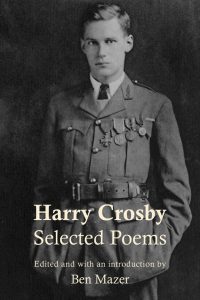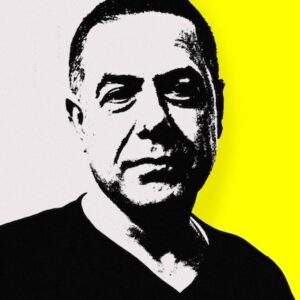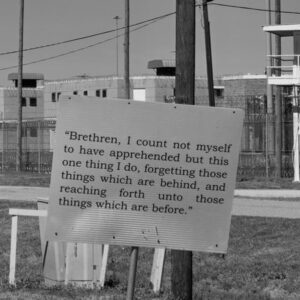
The Poet-Publisher Who Scorned Death by Pursuing It
Ben Mazer on the Wild and Profligate Life of Harry Crosby
It is sometimes said that poetry can kill a man, that, to the poet, poetry is a matter of life and death. Countless poets have encountered early or tragic death, many of them suicides: suicides from madness, from depression, from poverty, trauma, and even from belief in the hierarchal absolute of poetry. Rimbaud called for a derangement of the senses; many heeded the call, not least among them Harry Crosby, who, unlike Rimbaud, was wealthy, had already had his senses deranged by his war experiences, and was living with PTSD and mania.
Crosby revered Rimbaud, and with Rimbaud’s self-deregulation in mind, believed in his own idealizations of suicide. To his wife, Caresse Crosby, he had proposed suicide pacts on several occasions since early in their relationship.
He wrote about such pacts in his poems and in his diaries, and he talked about them, most consequentially, with the most significant of his many mistresses, Josephine Rotch Bigelow, with whom he was found dead in bed—a bullet hole to her left temple, a bullet hole to his right temple, his right hand holding a .25 caliber pistol, his free hand joined in Josephine’s—in a New York hotel room on December 11th, 1929.
The couple was fully clothed, and there was no suicide note. They had consumed immense quantities of gin and opium pills, not unusual for Harry, or his “fire-princess,” as he called Josephine, who, like himself, was thoroughly a product of Back Bay Boston. Had Josephine been the first to call Harry’s bluff, and insist that he carry through in action the belief he expressed to her, that the greatest expression and fulfillment of love was for two lovers to die together in suicide?
But where had the belief come from? Had it come from the derangement of his senses? Was he driven to suicide, as he was to the fatal calling of the poet, by his close experiences of death, violence and carnage in the First World War, experiences which drove his manic sexual drive, his commitment to poetry, to madness, to drugs and gambling, horses and medieval mills, Sun-worship, aviation, and books, while becoming one of the most elite and legendary publishers of the century with his and Caresse’s Black Sun Press in Paris?
When one thinks of Harry Crosby, one thinks of youth aflame, mad for love, drugs, poetry, speed, flight, tragic fatality, Sun-worship. One thinks of the enormous amounts of money that enabled him to live such a bigger-than-the-movies life. One thinks of the gruesome scenes and traumatic experiences that he witnessed in World War One as an ambulance driver. Old friends, and those who knew him intimately, thought the war was ticking away like a time-bomb in Harry.
Henry Grew Crosby was born in Back Bay Boston on June 4th, 1898, the son and heir of a wealthy banking family; his mother’s brother was J. Pierpont Morgan, Jr.; his father was a direct descendent of Alexander Hamilton. At St. Mark’s, the prescribed preparation for Harvard, Harry was a bit of a prankster, and excelled at track, but was mostly seen as a loner. Upon graduation in 1916, he enlisted in the American Ambulance Corps and by late June was in France.
Soon he experienced heavy battle conditions at Verdun, and saw gore that would impress him for life. He carried buckets of limbs. He wrote home:
I saw the most gruesome sight I’ve ever seen. Lying on a blood-stained brancard was a man—not older than 20 I afterwards ascertained—suffering the agonies of hell. His whole right cheek was completely shot away so you could see all the insides of his face. He had no jaws, teeth, or lips left. His nose was plastered in. Blood was streaming all over.
Then a shell exploded ten yards away from him, and he miraculously escaped being killed by jumping to the floor of his ambulance. He wrote his parents that on that day he had turned from a boy into a man. Somehow he was no longer afraid of death.
There is an Eliotic significance, a metaphysical fusion of the senses with the intellect, a sense of a cutting seriousness infusing Crosby’s poetry.
When he returned from France in 1919, a recipient of his treasured Croix de Guerre, he entered Harvard to take an accelerated war degree, and pleased his father by unenthusiastically making A.D. among Harvard’s final clubs. He didn’t make much of an impression at Harvard, and if he was interested in literature, nobody noticed it.
Before the end of his career at Harvard (he graduated in the spring of 1921), on July 4th, 1920, Harry’s mother introduced him to Polly Peabody, otherwise known as Mrs. Richard Rogers Peabody). He fell in love with her immediately, and within weeks was having sex with her and entreating her to divorce her husband and marry him. He wrote her:
I promise you that whenever you want we shall die together and what’s more I am perfectly ready now or will be anytime. With the absolute Faith that we shall be One in Heaven as soon as we die forever.
He obsessed on this theme in letters, offering it as a solution if she couldn’t get a divorce, even offering to kill her and then kill himself so that she “wouldn’t have to take the blame”.
Late in May 1921, Richard Peabody offered Polly a divorce, and they began a trial separation of six months. Polly promised her mother not to see Harry. Toward the end of the year Harry took a job with the Shawmut National Bank to please his father, and Polly began accepting weekend visits from him in New York. On January 1st, 1922, Harry began to keep his diaries, later published as Shadows of the Sun in three volumes (1928; 1929; 1930) by The Black Sun Press.
By March 14th he had resigned from the bank. A week later his mother secured him a job at the family bank in Paris. The Boston society columns wrote that the family and friends of the Crosbys hoped that Harry’s separation from Polly would break up their engagement, which had scandalized Boston. But Polly went to Paris to be with Harry, only to leave for America abruptly when Harry had an affair with another woman from Boston.
Harry cursed himself in his diary. Finally, he wired Polly that he couldn’t stand one more day without her and that he was coming to America and wanted her to meet him. She wired back, “YES”, and they were married on September 9th, 1922, in New York City.
The couple, with Polly’s two young children, took up residence in Paris, and Harry continued his bank work at Morgan, Harjes. The first mention of poetry in Harry’s diary had been on April 17th, when he had quoted from Baudelaire. Harry quit the bank at the very end of 1923; he wanted to be a poet. He had begun an intense friendship with his father’s cousin, Walter Van Rensselaer Berry (1859-1927), an international lawyer and man of the world who was friends with Henry James and Marcel Proust, and Edith Wharton’s writing master (she wanted to marry him, but he wouldn’t capitulate), an esteemed gentleman in Parisian social and literary circles.
It was Berry who encouraged Harry to leave the bank and write. As Walter Berry was an ornament to the family and its values, Harry wrote home triumphantly of Cousin Berry’s advice to him, which was received with perplexed incomprehension. Harry sank himself into studies of the French poets that Berry admired: Valéry, Verlaine, Baudelaire, and above all Rimbaud.
It was around this time that Harry began his course of Sun-worship, influenced by Berry’s obsession with Egypt. It was in April of 1925 that Harry and Polly announced to Berry that Polly would henceforth be known as “Caresse”. The name had been chosen to adorn Polly’s first book of poems, Crosses of Gold, which was being privately printed. Berry passed away in August 1927, and left his enormous collection of rare books to Harry and to Edith Wharton, with Harry in the end receiving the lion’s share of the library.
Crosby was possessed by worship of the Sun, by opium, by danger, by the impulse to make extravagant gestures, by sexual mania, by visions of a desired death and suicide.
Much else happened between 1925 and 1928. There were parties, racehorses (bet on and purchased), travel through North Africa (where Harry smoked hashish), endless perusal of books, and much smoking of opium. There were also Harry’s many sexual liaisons, though Caresse was always his favorite. Caresse, in turn, had affairs of her own.
Harry and Caresse set the tone of the Four Arts Ball in Paris each year. One year the theme was Inca. Harry dressed in a loincloth, his body covered in red chalk, wearing a necklace of dead pigeons. Caresse made her entrance bare-breasted riding a giant paper dragon carried by students.
Then there was Harry’s self-education as a poet. He was enamored of the Symbolists and the Decadents. His favorite poets were Rimbaud, Baudelaire, T. S. Eliot, e. e. cummings, and James Joyce. He read Wilde’s The Picture of Dorian Gray three times, copying out long passages from it in his diary. Caresse taught him how to write sonnets in 1924, and by 1925 he had enough for a book, Sonnets for Caresse, which the couple had privately printed, laying the beginnings of The Black Sun Press.
It wasn’t until the publication of Harry’s second book of poems, Red Skeletons, in 1927, that Harry and Caresse were to assume a name as a publishing house, Editions Narcisse, and, working for the first time with the printer Roger Lescaret, were to direct the design of their books. It was here that they first showed a flair for choice types, adequate margins, fine papers, interesting bindings, and innovative design, printed in tiny editions, often numbered in purple pencil.
A year later Crosby was dissatisfied by the book, and burned the remaining 80 unsold copies in a bonfire, shooting the four copies that didn’t burn to pieces with a shotgun.
Around this time Crosby began to show what poetic maturity marked the few brief remaining years of his violently short life. This mature period of Crosby’s poetry marks the volumes Chariot of the Sun (1928), Transit of Venus (1928; 1929 second edition, with added poems), Mad Queen (1929), Sleeping Together (1929), and Torchbearer (1931). It is from these five books that almost all of the poems in this edition have been drawn, though I have given every magazine and anthology text of these poems, as well as having drawn directly upon three of these collections.
What was Crosby’s poetry like? Since the original Black Sun editions, Crosby’s poems have simply not been available for perusal since 1931, with the exception of a scanty and generally ill-chosen smattering of his poetry sprinkled through Geoffrey Wolff’s biography (1976) and Edward Germain’s Black Sparrow edition of Crosby’s diaries, Shadows of the Sun (1977), which quote from Crosby’s immature sonnets, and some of his more violent and notorious tirades; nine rather more well-chosen poems appear in Jerome Rothenberg’s anthology Revolution of the Word (1974; second edition 2004).
Two of the marks of the true poet are singularity and authenticity. Spending whole days doing nothing but reading, turning out poem after poem in wild outbursts of energy, and laboring for hours over the revision of his work, Crosby had both. He had the singularity of a voice that sounds like no other.
There is an Eliotic significance, a metaphysical fusion of the senses with the intellect, a sense of a cutting seriousness infusing the poetry. There was the authenticity of one who means, as a matter of life or death, every word that he writes. When these two marks are fused, work comes violently to life, incomprehensible but compelling, something each reader might interpret or experience differently.
Although Crosby’s early work in Sonnets for Caresse and Red Skeletons was contrived and derivative, apprentice work, the poetry he wrote in the last two years of his life, 1928-1929, the years of a perhaps psychotic division of allegiances between Caresse Crosby and Josephine Noyes Rotch, were marked by a maturity of expression, an ability to fuse the elements of poetry. Looking at the poems alone, apart from the legendary biography, may be a reason to find more in them than was found during the years of their publication.
There is a divergence of styles in those last few Black Sun Press books. The poems in Sleeping Together, little-punctuated short prose poems, are surrealist in nature. The poems of Mad Queen and Torchbearer are more violent tirades. Transit of Venus presents extremely short, mostly unpunctuated poems in verse, terse and cryptic monographs on the madness of love. Take for example the poem “First Meeting”:
When you are the flower
I am the shadow cast by the flower
When I am the fire
You are the mirror reflecting the fire
And when Venus has entered the disk of the Sun
Then you are that Venus and I am the Sun.
The poems are strange yet original, perhaps crazy, for Harry Crosby was a man who was crazed—“half sane half insane” (Shadows of the Sun). As a poet he was possessed, certainly by the influence of Rimbaud, and in general the French poets from Baudelaire, or perhaps Villon, down to the surrealists whom he brushed shoulders with.
He was possessed by worship of the Sun, by opium, by danger, by the impulse to make extravagant gestures, by sexual mania, by visions of a desired death and suicide (the only question being, when was the right moment).
In Gatsby-like scenes, unknown wits might be found wandering around half-naked the morning after a particularly raucous party.
But what made it authentic, however childish, however given to incompletion or vagueness, however tiresome the repetitive symbols like incessant chants, was that Crosby had the conviction of his belief. As T. S. Eliot recognized, Crosby had a need to write in symbols, to effect his campaign around a tom-tom-beat background of key phrases and vocables.
To manifest one’s poetry through symbols was to seek after a solid truth that one could hang on to, even if another might not share one’s belief. Need another share it, if Eliot can posit that true poetry can only strike and affect each separate reader differently?
The Crosbys directed Lescaret in the printing of Harry’s Chariot of the Sun (1928), too, under the imprint “At the Sign of the Sundial”. But with the publication of Shadows of the Sun, on June 4th, 1928, Harry’s 30th birthday, a book bearing the imprint of The Black Sun Press was for the first time issued into the world.
Harry must have felt an elevation of esteem in his relationship with his parents, fooling around with book publishing, which to his parents must have had the hint of commerce about it, even if none of the words in the books could be understood. Perhaps the publishing enterprise gave them pause to think that Harry wasn’t wholly crazy.
The height of the Crosbys’ experience with The Black Sun Press was working with James Joyce on the numerous successive proofs to which Joyce subjected his text and the Crosbys during the course of preparing Tales Told of Shem and Shaun for publication. Harry, to whom Joyce was a God, was buoyant at the experience of hearing Joyce explain all the changes and additions he was making to the text.
Meanwhile other forces were shaping up. “Enter the Youngest Princess of the Sun!” reads his diary entry for June 9th, 1928. That day he had met 20-year-old Josephine Noyes Rotch at the Lido. She came from a prominent Boston family, and was in Europe to pick out her trousseau, as she had become engaged two weeks earlier to Albert Smith Bigelow, also of Boston.
Harry and his “Fire Princess” made the most of the eight days they had together in Venice. After returning to America, Josephine sent cables to Harry almost every day, and on the last day of July wired: “DO NOT BE DEPRESSED. TAKE THE NEXT BOAT. YOU KNOW I LOVE YOU AND WANT YOU.” Harry couldn’t bring himself to do it, and risk losing Caresse. By the third week in August, he had written 52 poems for Transit of Venus, his Josephine book.
Around this time the Crosbys took a 20-year lease on a medieval mill in Ermenonville, an hour away from Paris. The mill, which they bought for quiet and work, was soon opened to parades of revelers: royalty, movie stars (Douglas Fairbanks and Mary Pickford), poets (notably Hart Crane, visiting France on money given to him by the philanthropist Otto Kahn, and whose long, unfinished poem, The Bridge, Harry would soon offer to publish in a limited Black Sun Press edition), artists (Salvador Dali was a frequent visitor), nuts of all stripes.
In Gatsby-like scenes, unknown wits might be found wandering around half-naked the morning after a particularly raucous party, or six might take to one bed together, one of them a complete stranger.
On November 17th, 1928, Harry and Caresse docked in New York. In Boston on November 26th, Harry wrote in his diary: “the best part of the evening was the voice of fire over the wire.” On December 7th, the day the Crosbys were supposed to sail back to France, Harry vacillated as to whether or not to sail, and finally decided to remain behind in New York while Caresse returned to France; he would not rejoin her in Paris until Christmas Eve.
On November 16th, Harry and Caresse sailed for New York. Two days later, Harry received a radiogram from Josephine: “IMPATIENT.” On November 22nd, the Crosbys docked in New York. The next day, Harry visited Josephine before the Harvard-Yale football game. Harry saw much of Josephine in the next two weeks. The final entry in Harry’s diary reads:
One is not in love unless one desires to die with one’s beloved
There is only one happiness it is to love and to be loved
*
MadHat Press will be hosting a launch event for Harry Crosby’s Selected Poems on Monday, June 22nd, at 5pm EST. You can learn more here.
__________________________________

Adapted from the introduction to Selected Poems of Harry Crosby. Used with the permission of the publisher, MadHat Press. Introduction copyright © 2020 by Ben Mazer.
Ben Mazer
The Hierarchy of the Pavilions is Ben Mazer's tenth collection of poetry. Mazer was educated at Harvard University, where he studied with Seamus Heaney, and took his MA and Ph.D in Critical Editing and Textual Scholarship under Christopher Ricks and Archie Burnett at the Editorial Institute at Boston University. Mazer has edited The Collected Poems of John Crowe Ransom (Un-Gyve Press), and Selected Poems of Frederick Goddard Tuckerman (Harvard University Press), and is currently editing The Collected Poems of Delmore Schwartz for Farrar, Straus & Giroux.












